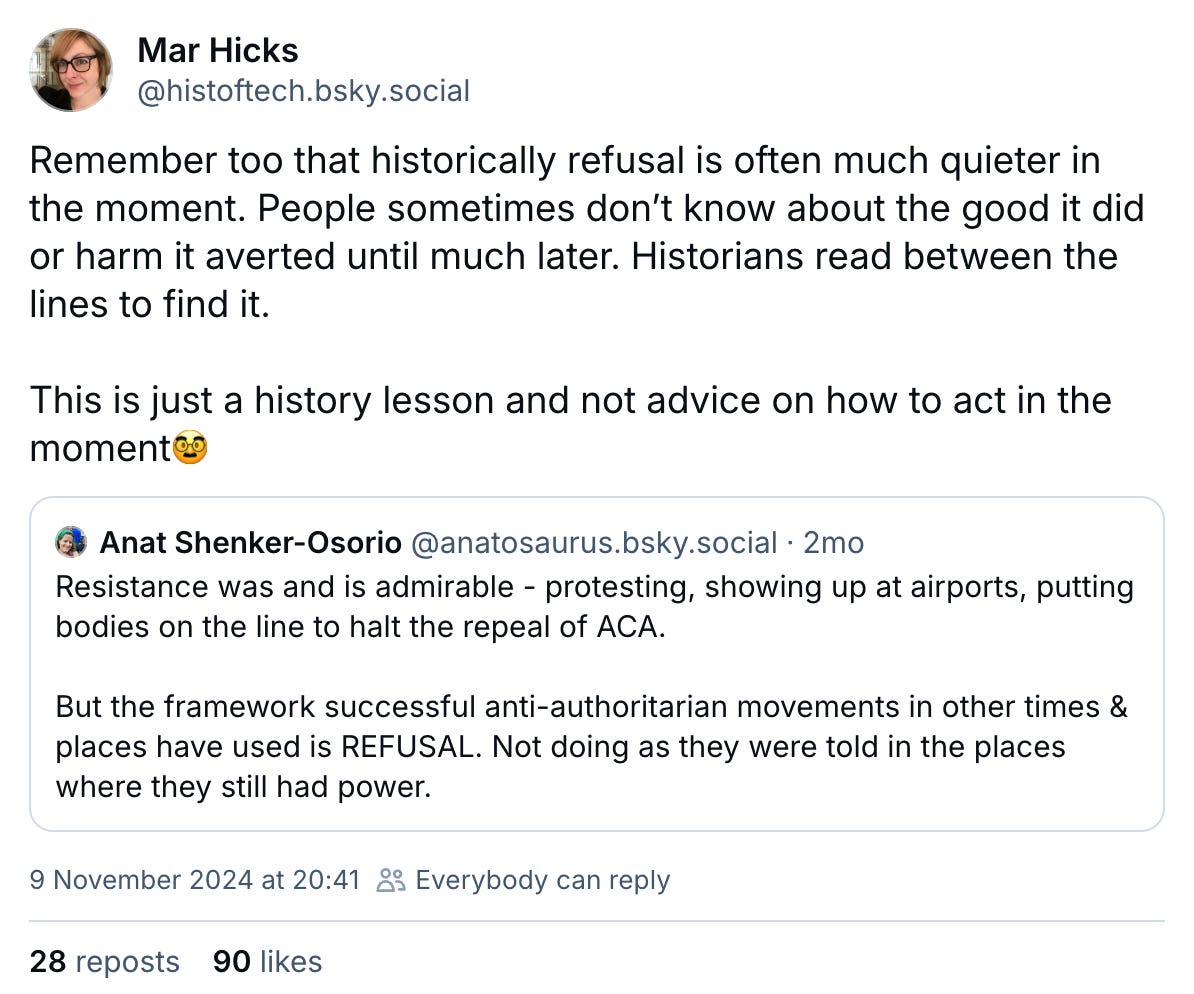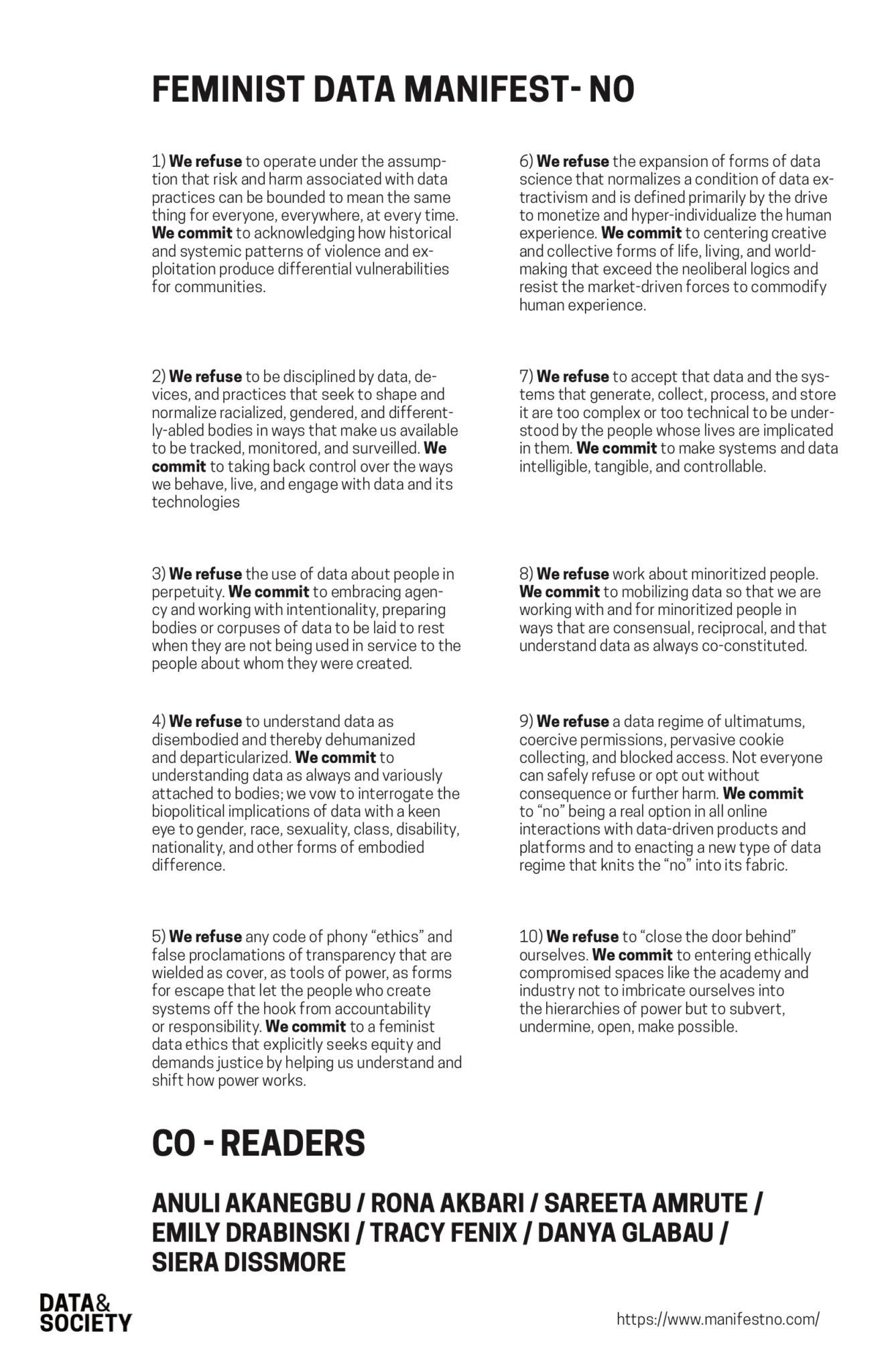Fifteenth #15: On refusal
Nope* as a method
Refusal as a generative and creative response to the continuation of harms excused as essential markers of technological progress
📚 You can buy books mentioned in this newsletter from my page on Bookshop.org
🏄🏾♂️ I spoke at Research by the Sea in Brighton a few weeks ago. The organisers at Clearleft have published a write-up of the day.

🚨 Announcement 🚨
This is the final edition of First & Fifteenth — for now.
I am putting my newsletter on hold. Think of this as the end of chapter 1 — an unsubtle clue about what I am working on next… 📖
The past year and a half has been an invigorating experience. I have got to know many of you — my readers and fellow Substackers. I have turned ideas that were mere scraps into fully formed essays. I have shared my insights, research and ideas on conference stages across the UK, Sweden, and beyond.
Each essay takes weeks, sometimes months, of research and drafting. My edit process often continues until hours before my auto-scheduler sends out the email.
I have an idea for another writing project, and I can’t do both at the same time, so it seems fitting to pause First & Fifteenth just as we reach edition number 15.
To all of you who come back again and again — thank you. Your continued interest has been an important motivation for me to continue.
To my paid subscribers — an even BIGGER THANK YOU. To vote with your wallet and support someone you knew little-to-nothing about has been such a boost. I have already suspended the collection of payments, so you are no longer being charged. If you have an annual subscription, it will stop the clock and will resume when I return to regular writing.
This is not the end. I will surprise you with an occasional review or essay now and again before resuming a regular schedule.
Until then, introduce yourself! I’m active on BlueSky, Instagram, and LinkedIn.
Digital, at any cost
When will we eliminate digital exclusion? Research by Lloyd’s Banking Group shows that the number of adults unable to engage with or use technology at a basic level has been on a downward trajectory for the last 3 years (currently approx. 0.9 million people, or 2% of the UK population).
Ofcom, the UK’s telecommunications regulator, has also published its strategy for tackling digital exclusion. One of the most common reasons given by adults who do not use the internet is a perceived lack of need.
Securing equitable access to digital technologies is a pressing concern. Ofcom frames the root causes around 3 A’s: Access, Ability, and Affordability.
A lack of access curtails a person’s ability to participate in civic and social life, to access financial services, or to make the most of free communication tools.
With always-on broadband at home and high-speed mobile data outside, expectations about the availability and access to digital services have risen: we expect transparency and traceability when we interact with local or national government; we demand payments that are instant; when we call friends or family, we expect HD-quality video regardless of whether they are in Adelaide or Aylesbury.
Digital exclusion and the strategies employed to tackle it are noble, and it seems the general downward trend will continue, albeit with regional, affordability and infrastructural challenges.
But I want to look behind and beyond the underlying question of tackling digital exclusion. Nestled beneath the premise of these wide-ranging initiatives is the belief that participation within digital economies is an assumed universal desire, betraying a deficit mindset that is preoccupied with “fixing” each individual’s situation through additive solutions — bringing more people into an information world that is transactional, extractive, and exploitative by design — while stepping over already existing social and community cohesion that has the misfortune of eliding capture of a technologist’s data regime.
The expansive technologist’s regimes — far from being a disparate collection of sectors, product lines, and infrastructural elements that repeatedly fall victim to accidental glitches — ought to be contended with as infrastructures that behave and increasingly resemble those of a territorially expansive State.
Look around

Our public spaces gesture to the transactional, extractive, and exploitative affordances that an ever-expansive digitisation demands, and the identities whose presence was overlooked as these technological futures were being made present.
It is the acceleration of a digital landscape where a shuttered bank branch greets us with a sign directing us to the nearest alternative 2.5 miles (or two bus rides) away.
It is the encroachment of self-checkouts accompanied by a cacophony of beeps and flashing lights that have prioritised space for efficiency over conversation.
It is the insistence that my receipt can only be sent by email if I just pop my email address in here.
It is the chatbot that exists in place of a once-helpful telephone line.
It is the joyful expressions of my Blackness being judged as a violation of your community standards and for the digital misogynoir flourishing on my feed because it is my fault for not locking down my account.
It is the milkshake spilled on my burger because the courier fell off their bike ten minutes ago and can’t afford to not finish their shift.
It is the expectation of having to submit to a bag or body search even though I have nothing to hide; and for the imaging software that alerts Security to the suspicious presence in my headwrap; it is for the scanning arch and its inability to see anything other than a binary gender assignment.
Tech as a State
Smartphone and app-based lifestyle services push us to live through the prism of a digitally mediated landscape — but this is a viewpoint that is privatised, raced, classed, and gendered.
Technological infrastructures and their most popular platforms have been subject to mergers and acquisitions of increasing size, leaving us with a landscape that is owned and run by fewer and fewer corporations — from the duopolies of Google and Apple dominating both the software running on their smartphones, via the walled gardens of their App stores, to the reshaping of knowledge where search results are prioritised on what an advertiser is willing to pay.
We are being served an information world that is suggestive of an ability to satisfy meandering curiousity, which in reality obscures how narrowly our exploratory efforts are curtailed by platforms more concerned with extracting financial gain from our parasocial interactions.
Our digital ecosystems have inherited affordances from a lineage of European and Anglo-American Modernity — ideologies concerned with declaiming colonial expressions of technological sophistication expressed through cultural artefacts. Interface design and visual modalities combine, in Adolf Loos’ words, to “eliminate the ornament”, in reference to a White European culture that has been visually codified, reproduced and disseminated at scale. These artifactual remnants linger to remind us, devoid of context, that there is really only one way to “do” design.
In essence, the pervading tension I feel is a struggle to thrive in a digital ecosystem where anti-Blackness is being embraced with increasing warmth.
Well might we consider beating a hasty retreat as Blackness falls foul of invisible standards that govern modes of acceptable discourse. From the Black Meme to the way Blackness takes up space online — somatic expressions that have existed with every iteration of mass communications technology — we are ensnared by the rules that police how Blackness is permissibly expressed online.
“As in the past, so it is today — the ways in which we take up space are first a cause of alarm, before becoming a catalyst for suspicion and eventually copied — made safe in a way — so that in the movements of another it can be broadcast.” — First #10: Review of Black Meme
Consider beating a hasty retreat from a digital ecosystem that presents a polished veneer of gender expressiveness while concealing the extractive data regimes that — through networks of data brokers — monetise the existence of its users through an exclusionary gender binary lens.
Digital products built on a foundation of racial capitalism parrot oft-repeated promises of freedom and choice before predictably ending in extraction and exploitation — a stark reminder that neutrality is far from the ideological concerns of these ecosystems.
From the disciplinary measures explicitly and implicitly imposed upon bodies deemed as marginal to the algorithmically mediated mismatch between the supply and demand for labour — the supranational existence of the largest digital platforms seemingly exist and operate everywhere while being meaningfully subject to civic or fiscal regimes nowhere.
On refusal

In 1969, the Black Panther Party began a mission to feed school-age children. Nutritious meals provided free of charge, each child was fed in a safe environment setting them up to learn effectively in the day ahead. Children and their accompanying adults were taught about Black pride, anti-capitalism, and self-sufficiency.
The first scheme opened in West Oakland, California. By the end of the year, they estimated that they fed around 20,000 children. The scheme's impact soon had noticeable and positive effects in each community they operated within, attracting support from Black and White communities alike. FBI director, J. Edgar Hoover, noted in a memo that the scheme represented “the greatest threat to efforts by authorities to neutralize the BPP and destroy what it stands for” and he intensified his efforts to eliminate the movement and its leaders.
It is absurd to imagine that the leader of the most powerful nation’s intelligence agency would feel so threatened by a community initiative in a few low-income neighbourhoods. When we contemplate the air of anti-blackness that pervaded the cities that many Black Americans lived within, after years of peaceful protest, pleading, and negotiating for basic civil rights, the realisation dawned that they were in contention with a power structure that had no respect for their humanity who cared little for their safety or wellbeing. So they refused.

Refusal is a gesture that, even in its smallest manifestation, contains the power to spur societal change. Years after the FBI succeeded in infiltrating and undermining the Black Panther Party, the federal government saw the necessity of introducing its own nationwide scheme to head off criticisms that they tolerated the neglect of children nationwide. A government-funded nationwide School Breakfast program was born.
Refusal is a necessary resort when faced with surviving within an ecosystem that, through its implicit and explicitly expressed values, threatens the safety of the marginalised. Despite its alliterative similarities, refusal is not resistance.
“... If resistance involves consciously defying or opposing superiors, then refusal rejects this hierarchical relationship, repositioning the relationship as one configured altogether differently.” — Theorizing Refusal: An Introduction
Refusal is protective because it is an embodied concern for the vulnerable. Its enactment is testament to the detection of any planned assault — whether white supremacy, racial capitalism, ableism, misogyny, queer or transphobia. It reassures me that the boundaries of my values have been demarcated and are encircled by my watchful protection.
Refusal is dignified because, like the Black Panther Party and their Free Breakfast for School Children Program, its enactment causes witnesses to reflect on their role in upholding systemic harm. A dignified refusal tells me that although we are sensually assaulted by the digital artefacts of an online culture where anti-Blackness is a memetic currency and the promotion of self has usurped community, intentional acts of care are far more valuable than the momentary high that 10,000 followers could ever afford.
“Refusal is a practice of “say[ing] no without being given a right to say no.” — Data Refusal from Below: A Framework for Understanding, Evaluating, and Envisioning Refusal as Design, pg. 3
Refusal is joyful because it is in dialogue with the future. Or rather, it is in dialogue with futures built on the foundations that Black refusal affords. It is a refusal to be read — where the presence of Blackness troubles the calculative gaze of extractive systems and their algorithms: there is agency in being incalculable. It is a refusal to be diminished — because we can glimpse past Eurocentric Modernity and embrace design vernaculars that operate to pluralistic aesthetics. Mind and body — a refusal to comply.
In the act of refusal — marginalised and buffeted by the affordances of a hostile digital environment — an individual finds community. Throughout Black history, we see how refusal is activated as the determined and targeted response to a violent ecosystem that has no respect for our personhood.
Interlude: Incantations to a Vague Borderland

“Delving into the intricacies of world-building in an ethereal, imagined plane — I interrogate ideas of solitude and belonging, the false dichotomies within intermediary spaces... Raised within the embrace of Afro-Caribbean and British cultures… my work is a reflection of a quasi-belonging, which invites both intimacy and loneliness…” — Gaia Ozwyn, artist statement
Incantations to a Vague Borderland (2024) is a 2 x 4 metre triptych by the London-based artist Gaia Ozwyn. Much of Ozwyn’s work is concerned with exploring the tensions of belonging and separation. Raised between Caribbean and British cultures, Ozwyn says of her work that it is “a reflection of a quasi-belonging, inviting both intimacy and loneliness.” In Ozwyn’s later works, she develops an interest in textural communication by using sand, and then concrete, to afford a sculptural quality to each work. With our preconceptions of beauty tested, our next thought may be to question why the boundaries of fine art reside where they do.
“I want to contend with the role of diasporic Blackness, pondering the conflicted relationship with the land, a territorial artefact defined as a possession in the Euro-American imaginary.” — Fifteenth #11: On reclaiming futures
Whatever the shape or size of the influence you occupy, you too can refuse. Refusal requires a distance — one that may be imposed rather than chosen.
Much like the visual dialogue and unsettling movement suggested across this expansive canvas, I am also contending with refusal through the lens of diasporic Blackness — agitating to ask who gave digital technocultures the permission to redraw the boundaries of who belongs.
Refusal as design

“These alchemic spaces of possibility, where we can speculate, burn shit down and build it up, where we can admit that we don't know and can endeavor to know. Where we can admit that we're frightened and ask for each other's care. Where we can and will burn it all down if we have to.” — “Manifesto of the As Yet Unlived Thing” by Phoebe Boswell, from The Alchemy Lecture: Five Manifestos for the Beautiful World, pg. 85
Thinking of Black refusal, I am at the early stages of contending with Afro-skepticism — a position set out at length in the recently published Technoskepticism: Between Possibility and Refusal (2025) by The DISCO Network — a loosely affiliated network of researchers, artists, and scholars who work to “envision new anti-racist and anti-ableist digital future(s)”
In their words:
“From this perspective, Afro-skepticism is the emotive process of acknowledging the human condition of Blackness while also leaving open the possibility for Black folks to negotiate the everyday state apparatuses, institutions, and available technologies for Black life and Black freedom. And as we explain in the Coda to this book, technology refusal can also be a practice of care.” — Technoskepticism, pg. 126, my emphasis
To turn refusal into a practice requires a consideration, not only of myself but of ourselves, chipping away at the centrality of the Individual Contributor — a figure so widely idolised in the functioning of our industry — letting that willingness to contradict the orthodoxy of our industry, ride roughshod over the constraints of job title or discipline.
Technologists are often too caught up with reaching utopia. This far-away place, in their view, requires wider, deeper, or more immersive technological intervention — propelled by whatever solution is the flavour of the current hype-cycle.
I disagree.
“… I imagine futures built on the foundations that Black refusal affords — a refusal to treat time as a commodity; a refusal to diminish the disruptive presence that Blackness affords in the gaze of a Eurocentric capitalist system; a refusal to let the scope or direction of my labour be directed by the extractive interests of a hegemonic White patriarchal system that initiates its critique from an incomplete cultural understanding and flawed sociotechnical foundation. Mind and body — a refusal to comply.” — Fifteenth #11: On reclaiming futures
So we search again. We need to find a route between unbridled optimism and crushing negativity. Futures exist already, and if we are passive consumers of an algorithmic feed, we may not realise that the visions which assault our senses daily are not inevitable.
Refusal as design looks for creative ways to reintroduce play and care into the fabric of the Web.
Play is crucial — no, not the superficial pursuit of chasing balls or rolling dice — but an inquisitive willingness to transgress. It is what The DISCO Network describes as an “act of trying to get to know a person, object, or technology without letting the baggage we carry as societally formed beings prematurely taint our conclusions” (pg. 157). It is within the act of play that we can refind our sense of liberatory imaginings.
Care is crucial because it is so closely tied to navigating our way through crisis. As we lament the loss of agency in curating spaces online and as we slowly realise we have been reduced to passive consumers within inflexible algorithmic gymnasia, it is a jerked reorientation that might aesthetically appear less polished but imbues the finished artefact with the sense of its maker. We can refuse digital ecosystems that are parasocially, materially, and computationally growing to an unsustainable scale reliant on unrealistic levels of growth, scale, and extraction.
“… care is interwoven, invisibly or explicitly, with technoskepticism. Our thinking around the possibilities or perils that emerging technologies might present must be grounded in the care we have for our communities and for each other. In that sense, we see technoskepticism as an ethic of care: the possibilities we might seize from emerging technologies, as much as the power to be gained from refusing others, are meaningful because they enable us to better care for ourselves and each other.” — Technoskepticism, pg. 185, my emphasis
This is an invitation to conspire — and I mean this in the archaic sense: conspirare “to breathe together.”
We have imbibed the technologically mediated language of community and connection but have forgotten how to breathe. To conspire, to breathe together, is to be somatically connected. In community and in dialogue.
To conspire is a sensemaking exercise that rejects the binary, top-down, organising logics of technoculture, seeing our humanity as being far more than the sums of a database’s record or a machine learning model’s output.
To conspire reminds us that we each need to breathe again, unmediated by the interventions of digital platforms that supplant so much of our emotion and affection and resell reduced and distorted algorithmic versions of ourselves.
It is in this spirit that we can conspire (breathe) to draw liberatory futures closer to ourselves.
Explore further
Listen
Transcripts are available for Decolonial AI 101 with Raziye Buse Çetin, and Time.
Read
Bartleby, The Scrivener: A Story of Wall-Street by Herman Melville (Originally published in Putnam's Magazine, 1853, 45 pages; this story is out of copyright, so you can get the text (legally) for free online at Project Gutenberg)
Technology and Its Discontents: On the Verge of the Posthuman by Joel Dinerstein (American Quarterly, vol. 58, no. 3, September 2006, pages 569-595)
Theorizing Refusal: An Introduction by Carole McGranahan (Cultural Anthropology, vol. 31, no. 3, 2016, Openings and Retrospectives)
Black visuality and the practice of refusal by Tina M. Campt (Women & Performance, 2019)
Glitch Feminism: A Manifesto by Legacy Russell (Verso, 2020, 178 pages)
The Gentrification of the Internet: How to Reclaim Our Digital Freedom by Jessa Lingel (University of California Press, 151 pages, 2021)
Refusal in Data Ethics: Re-Imagining the Code Beneath the Code of Computation in the Carceral State by Chelsea Barabas (Engaging Science, Technology, and Society, vol. 8, no. 22, 2022)
Data Refusal from Below: A Framework for Understanding, Evaluating, and Envisioning Refusal as Design by Jonathan Zong and J. Nathan Matias (ACM Journal on Responsible Computing, 2024, vol. 1, no. 1, pages 1-23)
No by Iryna Zamuruieva (DING, issue 6, 2024)
Resisting Racial Capitalism: An Antipolitical Theory of Refusal by Ida Danewid (Cambridge University Press, 2024, 266 pages)
“Introduction: Learning to love machines again” by Alex Haché, taken from Technological Sovereignty, vol. 2 (Published independently via Gitbook, 2024)
Track Record: Me, Music and the War on Blackness by George The Poet (Hodder & Stoughton, 2024, 271 pages)
We Refuse: A Forceful History of Black Resistance by Kellie Carter Jackson (Seal Press, 2024, 304 pages)
My Biological Archive by Eileen Ahn (Reboot, 2025)
Technoskepticism: Between Possibility and Refusal by The DISCO Network (Stanford University Press, 2025, 240 pages)


This is a brilliant piece of thinking and writing. Your talk on this kept with me and to read it has made me think in many different ways. There are many thoughts but this quote is very power full and signifies the normality of whiteness
“Our digital ecosystems have inherited affordances from a lineage of European and Anglo-American Modernity — ideologies concerned with declaiming colonial expressions of technological sophistication expressed through cultural artefacts. “